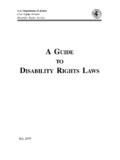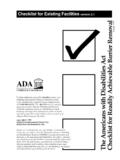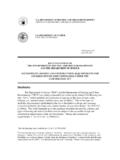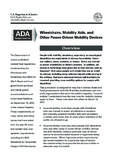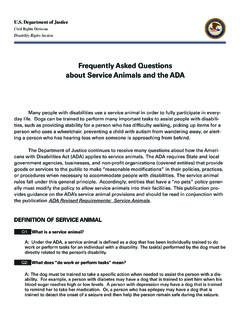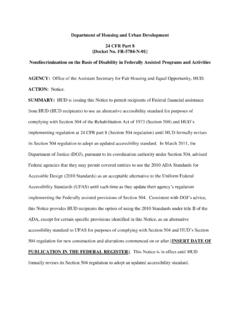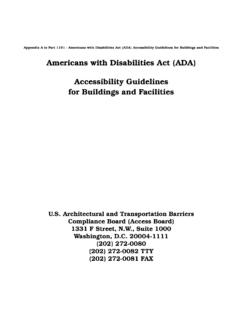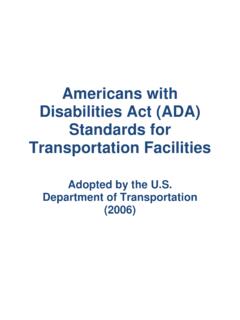Transcription of ADA Accessibility Survey Instructions: Curb Ramps
1 NOTICE Portions of this appendix may not fully reflect the current ADA regulations. The regulation implementing title II of the ADA was revised as recently as 2016. Revised ADA Standards for Accessible Design (2010 Standards) were issued on September 15, 2010 and went into effect on March 15, 2012. Additional related information can be found in the Department of Justice/Department of Transportation joint 2013 publication and 2015 publication. ADA Accessibility Survey InstructionsCurb RampsPage 1 of 6 ADA Accessibility Survey Instructions: Curb Ramps1[ ]Only measure the width of the ramp section ofthe curb ramp (labeled ramp to the right). Theramp section of a curb ramp is also known asthe ramp run. If the curb ramp has flaredsides, which can also be seen in the illustrationto the right, do not include them in themeasurement. The ramp run must be at least36 inches wide.
2 2[ ; ; (3)(a)]The running slope of the curb ramp is the slope in the direction that people travel whengoing up or down the ramp run. The arrow in the illustration to the left, aligned parallelto the ramp run and perpendicular to the curb,shows where to measure the running slope. For new construction (when the curb ramp wasbuilt after January 26, 1991), the running slopeof the ramp run must not exceed percent. For alterations (when the curb ramp wasaltered after January 26, 1991), the slope mustnot exceed 10 percent for a 6-inch rise percent for a 3-inch [ ]The cross slope of the curb ramp isperpendicular to the running slope. Unlike therunning slope, which runs along the ramp, thecross slope is measured across the ramp. Thearrow in the illustration to the right, alignedperpendicular to the ramp run and parallel to thecurb, shows where to measure the cross slope.
3 The cross slope of a curb ramp, or anyaccessible route, may not exceed 2 Accessibility Survey InstructionsCurb RampsPage 2 of 64[ ]The gutter is the part of the street that bordersthe curb. To measure the gutter slope, placethe level in the same position as the arrow in theillustration, with one end where the gutter meetsthe ramp and the other end towards the street. The gutter slope is parallel to the ramp andperpendicular to the curb. The gutter may slopeup to 5 percent towards the curb ramp, but notmore. 5[ ]The transitions on and off the curb ramp are the pointswhere the gutter meets the bottom of the ramp and wherethe top of the ramp meets the sidewalk. These transitionpoints are required to be flush and cannot have anyabrupt level changes. Record any level change at [ ]Detectable warnings are dome-shaped bumps that should cover the entire width anddepth of the ramp run.
4 Detectable warnings are designed to be felt underfoot or with acane by people who are blind or have low vision, thereby alerting them of hazards mainly, the transition from a pedestrian-only area to a the curb ramp you are surveying has detectable warnings but they do not cover theentire ramp run, explain how they are different in the Comments section at the bottomof the form. For curb Ramps along public streets, the Department of Transportation(DOT) has deemed permissible a strip of detectable warnings that stretches across thewidth of the ramp run but covers only the two feet nearest the road. If the curb rampyou are surveying is located along a public street, you may circle "Y" if the detectablewarnings comply with the DOT s design. ADA Accessibility Survey InstructionsCurb RampsPage 3 of 67[ ]Curb Ramps must be located where they will not be obstructed by parked vehicles.
5 Ifthe curb ramp you are surveying is along a public right-of-way or at a pedestriancrossing, vehicles should be prohibited from parking directly in front of the curb ramp onthe street. If the curb ramp you are surveying is part of the accessible route from aparking lot to a building, the curb ramp may not lead into a parking space because thecurb ramp will be obstructed when a vehicle parks in the [ ; ]Curb Ramps should have atleast 36 inches of clear spaceat the top of the ramp, whichcan be seen in the illustrationto the right. The 36-inch spaceat the top of the ramp allowspedestrians who are continuingalong the sidewalk to bypassthe curb ramp without travelingover measurement shouldextend from where the ramprun meets the level sidewalk (at the lower end of the arrow) to the opposite edge of thesidewalk (where the sidewalk meets the grass). Do not include any part of the curbramp in this measurement.
6 9[ ]Curb Ramps either have flared sides or vertical edges called returned curbs. Using theillustrations below, determine whether the curb ramp you are surveying has flared sidesor returned curbs and answer accordingly. The next two questions relate to the slope offlared sides, and you should answer them only if you determine your curb ramp hasflared sides. If your curb ramp has returned curbs, skip to question Accessibility Survey InstructionsCurb RampsPage 4 of [ ]If the sidewalk at the top of the ramp ( x in theillustration) is 48 inches wide or more, answerthis question. If x is less than 48 inches, skipthis question and answer the next one. To answer this question you need to determinethe slope of the flared sides to make sure it is10 percent or measure the slope of a curb ramp s flaredside, place a level on the flared side near theedge of the curb.
7 The level should be placedso that it is parallel to the curb. Place thelevel in the same position and location aseach of the arrows in the illustration to the [ ]If the sidewalk at the top of the ramp ( x ) isless than 48 inches wide and the curb rampyou are surveying has flared sides, answer thisquestion. Otherwise, skip this question. To measure the slope of the curb ramp s flaredside, place a level on the flared side near theedge of the curb. The level should be placedso that it is parallel to the curb. Place the level in the same position andlocation as each of the arrows in theillustration to the left. The slope of the curbramp s flared sides may not exceed when there is less than 48 inchesbetween the top of the curb ramp and theedge of the sidewalk at the other side ( x ).ADA Accessibility Survey InstructionsCurb RampsPage 5 of 610[ ]Answer this question only if you skipped theprevious two questions because the curb rampyou are surveying does not have flared Ramps must have flared sides unlesspedestrians would not normally walk across theramp.
8 A curb ramp may have returned curbs ifit has non-walking surfaces (such as grass) orobstructions on both sides because theseconditions would normally discouragepedestrians from walking across the ramp. Generally, an object will qualify as an obstruction if it is immovable and is large enoughto make it unlikely that pedestrians will walk across the [ ]A built-up curb ramp typically consists of asphalt or concrete that is poured and shapedinto a ramp that runs at a 90-degree angle away from an intact curb down to theroadway. Built-up curb Ramps cannot project into the path of cars. The path of cars includes anywhere cars are allowed todrive, including roadways, parking lot driveways, parkingspaces, and access curb Ramps should have flared sides with a slopeof 10 percent or less or have edge protection andhandrails on the [ ]When a curb ramp is located at a marked crossing, the area where the ramp run endsmust be contained within the marked crossing.
9 The flared sides of a curb ramp do nothave to be within the marked Accessibility Survey InstructionsCurb RampsPage 6 of 613[ ]A corner-type curb ramp is located at the center (orapex) of a corner and is often aligned to direct usersinto the middle of an intersection. As the illustrationon the right shows, the alignment of a corner-typecurb ramp means that people who travel down theramp might be near the path of vehicular traffic oncethey enter the street. Therefore, if a marked crossingor crosswalk is provided, there must be a 48-inchdeep area contained within the markings at thebottom of the ramp to protect people after theydescend the taking this measurement, the measuring tape should be aligned parallel to theramp run itself and should stretch from the intersection of the ramp and gutter to theinnermost edge of the pavement marking. The Americans with Disabilities Act authorizes the Department of Justice (the Department) to provide technical assistance to individuals and entities that have rights or responsibilities under the Act.
10 This document provides informal guidance to assist you in understanding the ADA and the Department's regulations. This guidance document is not intended to be a final agency action, has no legally binding effect, and may be rescinded or modified in the Department s complete discretion, in accordance with applicable laws. The Department s guidance documents, including this guidance, do not establish legally enforceable responsibilities beyond what is required by the terms of the applicable statutes, regulations, or binding judicial precedent.


